 Image search results - "sendai" Image search results - "sendai" |

JR Sendai Station on the west side (Nishi-guchi). This is the main side. There is a tourist information office inside the station where you can pick up maps and pamphlets, maybe in English too.
|
|

Inside Sendai Station, heading to train platforms.
|
|
|

Trains in Tohoku have a door open/close button to save on air-conditioning or heating.
|
|

Morning rush hour at Sendai Station. People heading for the exit inside Sendai Station.
|
|

Outside Sendai Station, they are constructing the Tozai subway line due to open in 2015.
|
|

Poster for the new Tozai subway line in Sendai to open in 2015.
|
|

Subway stations on the existing subway line in Sendai.
|
|

Kotodai Koen subway station in Sendai. Modern and clean subway.
|
|

Subway train in Sendai.
|
|

Inside Sendai subway train.
|
|

Sendai subway station
|
|

On escalators in Sendai, they stand on the right side. (Not on the left side as in Tokyo.)
|
|

Bus stop outside Sendai Station.
|
|

Sendai City Loop bus goes to the major tourist spots in Sendai. Most convenient to get to Sendai Castle. 250 yen per ride or 600 yen for a day pass.
|
|

Route of the Sendai Loop bus. Get off at Sendai-joshi to see Sendai Castle. The bus will take you all the way to the top of the hill where the castle is. Much easier than walking up.
|
|
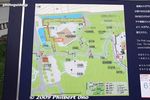
Map of Sendai Castle site. It's quite a large site, with museums and other facilities occupying the former castle site. The Honmaru (partially hidden) is on the right of the map.
|
|

Site of Nenomon Gate. This leads to Sendai City Museum in the castle area called Sannomaru. 子門
|
|

Goshikunuma Swamp is a moat of Sannomaru.
|
|

Sculpture in Sannomaru.
|
|

Stone wall at the site of Otemon Gate.
|
|

Waki-yagura turret at the site of Otemon Gate.
|
|

Sendai Castle's Waki-yagura turret at the site of Otemon Gate. Reconstructed in 1965. We cannot enter it. 脇櫓
|
|
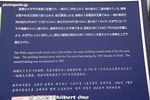
About the Waki-yagura turret.
|
|

The original Otemon Gate was here, between the Waki-yagura on the right and stone wall on the left.
|
|
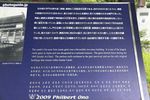
About the Otemon Gate.
|
|
|

Waki-yagura turret at Sendai Castle.
|
|

Statue of Hasekura Tsunenaga acros the road from the Waki-yagura.
|
|

Statue of Hasekura Tsunenaga, a samurai retainer of Date Masamune who sent him to the Vatican in 1613. 支倉常長
|
|

As you climb up the Aobayama, you pass through the sites of former gates. This one was Nakanomon Gate. 中門
|
|

Climb further and you'll reach large stone walls, called the Honmaru northern stone wall.
|
|

Corner of Honmaru northern stone wall.
|
|
|
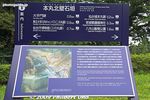
The area has these nice multi-lingual plaques explaining the points of interest with a map included.
|
|
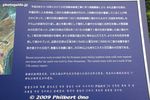
About the Honmaru northern stone wall.
|
|

Honmaru northern stone wall.
|
|

Next to the Honmaru northern stone wall is this large torii gate and steps going up to the Honmaru, the castle's central keep. This place in front of the torii was a parking lot before. Glad that parking is no longer allowed here.
|
|

Sendai Castle site's torii. The torii is here because there's a Shinto shrine in Honmaru.
|
|
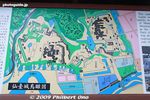
Map of the original Sendai Castle also called Aobajo or Aoba Castle since the castle is on Aobayama or Mt. Aoba. Sumo fans might know the name Aobajo, a sumo wrestler from Sendai active in the 1980s.
|
|

Honmaru is a large flat area overlooking central Sendai. This was where the castle palace was, the castle lord's actual residence.
|
|

Lookout point on Sendai Castle's Honmaru.
|
|

View from Sendai Castle's Honmaru. Sendai has over a million people. On clear days, you can also see the Pacific Ocean.
|
|

View from Sendai Castle's Honmaru.
|
|

Sendai Castle's Honmaru.
|
|

View from Sendai Castle's Honmaru.
|
|
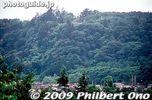
From the city, this is what the castle site looks like on Aobayama. You can see the lookout deck.
|
|

Waki-yagura as seen from afar.
|
|

Statue of Lord Date Masamune at Sendai Castle's Honmaru. Very popular for picture-taking.
|
|

Statue of Lord Date Masamune at Sendai Castle's Honmaru. One of the most popular and famous samurai of all time.
|
|

Statue of Lord Date Masamune at Sendai Castle's Honmaru.
|
|

If you look closely, you can that see one of his eyes is blind.
|
|

Sample stone work on a castle wall.
|
|

These are original Edo Period stones removed when the stone wall was renovated. These stones could not be reused.
|
|

Sample stone work on a castle wall.
|
|

Triangular stones are used.
|
|
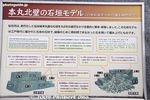
About the sample stone walls.
|
|

Sendai Castle marker
|
|

Monument for the war dead.
|
|

Monument for Doi (Tsuchii) Bansui who created the song, "Kōjō no tsuki" (荒城の月 lit. "Moonlit castle ruins") which is about Sendai Castle. 土井 晩翠
|
|

Also in the Honmaru area is Gokoku Shrine decorated here during the Tanabata Star Festival in early Aug. 宮城縣護國神社
|
|

Miyagi-ken Gokoku Shrine enshrines Miyagi Prefecture's war dead since 1868. There are over 56,000 war dead.
|
|

Miyagi-ken Gokoku Shrine in Sendai Castle. Emperor Hirohito as well as Crown Prince Akihito (current emperor) visited this shrine to pay their respects. 宮城縣護國神社
|
|

Kamikaze suicide fighter pilot memorial next to a war museum within the shrine.
|
|

Votive tablets for sale at Gokoku Shrine. Special tanabata ones during early Aug.
|
|
|

Lucky Alex...
|
|

Small museum in Honmaru showing results of excavation work and stone wall reconstruction.
|
|
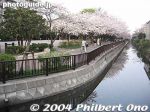
This is one end of Sendaibori Park, also running along along a river. It also intersects with Yokojukken River.
|
|

Sendai International Center
|
|
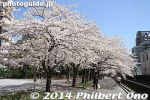
Sendaibori Park is noted for cherry blossoms in late March to early April.
|
|

Hirose River, teeming with wildlife.
|
|

Street lamp
|
|
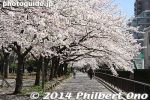
Sendaibori cherry blossoms. This part of the park runs west to east.
|
|

City of trees on a main road in Sendai.
|
|
|
|
|
|
|
|
|
|
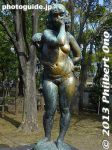
Sendaibori, Koto-ku, Tokyo. Mother and child statue.
|
|
|
|
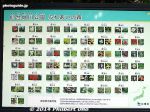
Sendaibori Park makes the 90-degree turn northward. This section has the official trees of all 47 prefectures.
|
|
|
|
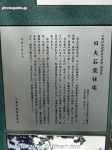
About the former Oishi family home.
|
|

The park also has Koto Ward's oldest house, the former Oishi family home built over 160 years ago in the late Edo Period. 旧大石家住宅
|
|
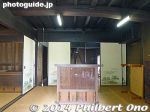
The former Oishi family home is open 10 am–4 pm on weekends and national holidays only. Free admission. Moved here in 1996.
|
|

You can see a good example of Meiji Era household items in the house.
|
|
|
|
|
|
|
|
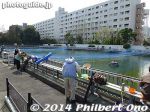
Fish pond open in summer and winter.
|
|
|
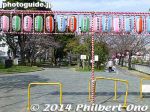
Another entrance to Sendaibori Park from Kasaibashi-dori road.
|
|
|
|
|
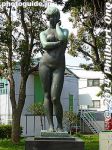
Sculpure at Sendaibori Park, Koto-ku. Tokyo
|
|
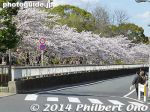
Sendaibori Park from Kasaibashi road is another prime section of cherry blossoms.
|
|
|
|
|
|
|
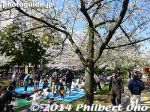
Hanami flower viewing is popular among the locals.
|
|
|
|
|
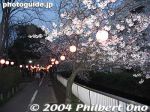
In the evening, paper lanterns light up the flowers.
|
|
|
|
|
|
|
|
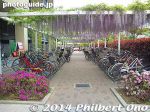
Ario Kita-suna Mall in spring with wisteria hanging over parked bicycles. Shopping mall is not far from Sendaibori Park.
|
|
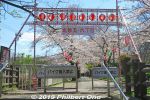
The northern end of Sendaibori Park.
|
|
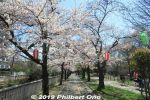
Walking down Sendaibori Park from the northern end.
|
|
|
|
|
|
|
|
|
|
|
|
|
|
|

Not far from Sendaibori Park is Heisei Bridge on the border with Edogawa-ku. It was built in Dec. 1994 (Heisei 6). 平成橋
|
|

Held annually during Aug. 6-8, the Sendai Tanabata Matsuri is Japan's largest, grandest, and most famous Tanabata Festival. Commonly called the Star Festival, Tanabata Matsuri features large colorful, streamer decorations (called take-kazari).
|
|

I arrived in Sendai on Aug. 4, 2009, two days before the festival, and Sendai Station here was already decorated with these huge tanabata streamers. Very impressive.
|
|

Many of the Tanabata streamers are quite commercial, with sponsors prominently displayed on the streamers.
|
|

Inside Sendai Station's west side. A great greeting for visitors to Sendai during Tanabata Matsuri.
|
|

The festival is said to have originated from a Star Festival in China. According to Chinese legend, east of the Milky Way there was a Heavenly King whose daughter worked as a weaver. However, when she married a herdsman, she quit weaving.
|
|

This angered her father who banished the herdsman to the other side of the Milky Way. He allowed the two to meet only once a year on the evening of the seventh day of the seventh month (according to the lunar calendar).
|
|

The weaver is represented by the Vega star and the herdsman by the Altair star. As a prayer to produce better arts and crafts, the Imperial Court and the warrior class paid homage to these two stars from ancient times. This practice spread to the masses.
|
|

In Sendai, famous daimyo Date Masamune had the warrior and merchant classes observe the Star Festival.
|
|

During the Tohoku Industrial Expo in 1928, the forerunner of today's Tanabata Festival was held. Sendai merchants strived to uphold the tradition, resulting in today's elaborate and gaudy Tanabata decorations.
|
|

According to the legend, the original date of Tanabata is July 7 according to the lunar calendar which is about a month behind the calendar we use today. Some places hold the festival on July 7 to match the original, numeric date.
|
|

You can see Tanabata in various locations (smaller scale) in Japan such as Hiratsuka in Kanagawa held around July 7 and Asagaya and Fussa in Tokyo around Aug. 7.
|
|

Inside Sendai Station is a large information booth where you can obtain maps and pamphlets of Sendai and Tanabata Matsuri.
|
|

Tanabata decorations at the entrance of Sendai Station.
|
|

It rained sometimes during the Tanabata Festival since the Tohoku region was still in the rainy season.
|
|

Tanabata decorations outside S-PAL, a shopping complex next to Sendai Station.
|
|

The pedestrian overpass connected to Sendai Station is also decorated.
|
|

On Aug. 4, two days before the start of Tanabata Festival, the shopping arcades already had these bamboo poles with ropes set up.
|
|

Pieces of bamboo hung from the ropes on bamboo poles.
|
|

Sendai's shopping arcades were obviously designed for tanabata decorations. There are eyelets or hooks for ropes on the ceiling.
|
|

The walls also have eyelets/hooks for ropes to support the bamboo poles.
|
|

This large tanabata bamboo was being set up on Aug. 4.
|
|

Drilling
|
|

Attaching ropes. The decorations will later be attached to these ropes.
|
|

Hoisting up the bamboo support pole.
|
|

On the evening of Aug. 5, the Tanabata Festival Eve, a fireworks display is held at Nishi Koen Park. Here are many girls in yukata waiting for friends at Sendai Station to see the fireworks.
|
|

Nishi Park in Sendai is full of people on fireworks night.
|
|
|
|

This road was filled with people as well for the fireworks.
|
|
|

Sendai Tanabata Fireworks on Aug. 5, 7:30 pm to 9 pm. It was impressive. The theme was "Ring of Love."
|
|

On the morning of Aug. 6, the first day of Sendai Tanabata, shop owners started to set up their tanabata bamboo decorations from around 8 am to 9 am.
|
|

One bamboo pole has several decorations and each one hangs on a rope.
|
|

Setting up Tanabata bamboo decorations.
|
|
|

This decoration had little owl-shaped paper balloons. These girls are blowing air into the balloons with a straw. Sendai Tanabata.
|
|

Attaching the ball to the body of the decoration.
|
|

The decorations usually arrive in huge plastic bags, especially the outdoor ones. This is the Fujisaki decoration.
|
|

When the decorations are unpacked or unraveled, they are freshened up.
|
|

These people are spreading the wings of the origami cranes.
|
|
|

The decorations can cost thousands of dollars or even tens of thousands of dollars (US$). (Hundreds of thousands of yen or a few million yen.)
|
|

After the festival ends, many of these decorations are discarded. But some are donated to a shopping arcade in Fukuoka (Kyushu).
|
|

Many decorations are really advertisements. But others have no ads and they are splendid. Keep in mind that the Tanabata Festival was started by local merchants, so it has commercial roots. It's not a religious event.
|
|

Tanabata Matsuri is held in many parts of Japan, usually in shopping arcades to draw customers. The more famous ones are in Hiratsuka in Kanagawa and Asagaya in Tokyo.
|
|

By 10 am on the first day of Aug. 6, most all of the Tanabata decorations were set up. Large crowds soon followed.
|
|

The shopping arcades on the west side of Sendai Station is where the Tanabata decorations are. The main arcades where you can see the streamers are basically on two arcade roads: Chuo-dori and Ichibancho-dori. They intersect at a T-intersection.
|
|

The Chuo-dori arcade is about 750 meters long. Although this arcade is a straight and continuous road, it is actually consists of three seamless arcades named Hapina Nakakecho (ハピナ名掛丁), Clis Road, and Marble Road Omachi.
|
|

This is the Hapina Nakakecho arcade. "Hapina" stands for "Heartful Amenity Place Interfaced Natural Arcade." It also refers to "happy." When the Japanese create a new name, they love puns.
|
|

This was my second time to see Sendai Tanabata. The first time was quite some time ago. I had high expectations, and I was not disappointed.
|
|

The take-kazari bamboo decorations were marvelous. A myriad of designs and variety. Paper was the main material used to make all these decorations, unlike the predominant plastic found at other Tamabata Festivals in Japan.
|
|

These decorations cannot be massed produced, all one of a kind.
|
|
|

During the morning of Aug. 6 the first day, a team of judges wearing a white cap and yellow shirt proceed through the decorations for judging. Dressed in pink is the back is one of the three Sendai Goodwill Ambassadors (not Miss Tanabata).
|
|

The decorations are given awards such as the Gold and Silver Awards. The winners are announced later in the day, and the winning decorations are tagged with the awards. This is the Gold Award.
|
|

Silver Award. Besides awards for individual decorations, awards are given to the shopping arcade as a whole for the bext decorations.
|
|

Extravagant Award
|
|

This one was clearly a crowd favorite, and not surprisingly, it won the Outstanding Award.
|
|

It's nearly impossible to define or describe an outstanding decoration, but you know it when you see it.
|
|
|
|

Gold Award + Outstanding Award.
|
|

The crowd take pictures in front of this Outstanding Award decoration.
|
|

Closeups of one of the best take-kazari of 2009.
|
|
|
|
|

Many girls (and kids) dressed in yukata (cotton kimono) came to see the Tanabata Festival. Her facial reaction was typical.
|
|

The streamers can also be quite hypnotizing if not captivating.
|
|

People who wear yukata know how to enjoy each of Japan's seasons.
|
|
|
|

The yukata has become quite modern. You no longer have to put your hair up when wearing one.
|
|

Eye-catching trio of yukata-clad girls.
|
|
|

Kids loved to jump and try to touch the streamers.
|
|
|
|
|
|

Tanabata appeals to all ages, from little kids to grandmothers.
|
|
|
|
|

Interview by local TV.
|
|

Another crowd favorite was these streamers made of tiny origami paper cranes.
|
|

This was the 34th Tanabata Decoration of Peace. Aug. 6, the first day of the Sendai Tanabata Matsuri, also happens to be the anniversary of the Hiroshima atomic bombing.
|
|

It says "No More Hiroshima."
|
|

Tiny origami paper cranes. Guess how many paper cranes there are? Over 1 million.
|
|

Peace message.
|
|

Organizations who made the 1 million+ paper cranes. About 25,000 people from all over Japan from age 5 to 103 made over 1 million paper cranes. That's an average of 40 cranes per person.
|
|

Bottom of the paper cranes.
|
|

People were amazed at these cranes. This is one type of streamer you won't see at other Tanabata Festivals in Japan.
|
|
|
|

Origami paper cranes is actually one type of Tanabata decorations. Many decorations had paper cranes as you can see here.
|
|

Origami paper cranes.
|
|
|
|

Regular-size paper cranes.
|
|

Hapina arcade
|
|
|
|
|
|
|
|
|
|
|
|
|
|
|
|
|

Puppets
|
|

Ichiban-cho Yon-chome arcade is outdoors.
|
|
|
|
|

Write your wish on a paper tag and affix it to the bamboo branch.
|
|

Kids writing their wishes.
|
|

Perhaps she wished for a rich husband.
|
|
|
|
|

Fujisaki's decoration is at the T-intersection between Chuo-dori and Ichibancho-dori.
|
|

This is Sun Mall Ichibancho. This Ichibancho-dori road is also straight, but consists of three seamless shopping arcades: Sun Mall Ichibancho, Brand Dome Ichibancho, and Ichibancho Yon-chome.
|
|

Sun Mall Ichibancho
|
|
|
|
|